The picturesque valleys and mountains of Missouri cascade into fierce and gorgeous rivers. Many rivers in the state are home to adventure water sports like white water rafting, kayaking, fly fishing, and more. That’s not all they’re home to, though. These waters also host a variety of snakes — so many that the snake populations have deemed five rivers in Missouri as some of the most snake-infested in the nation.
Discover the top five most snake-infested rivers in Missouri, why rivers boast such a great habitat for snakes, and how to deal with unexpected snake encounters during a chill day on a Missouri river.
Snake-Rich Ecosystems Along Rivers

Missouri Rivers provide a perfect habitat for many water snakes.
©Kit Leong/Shutterstock.com
Missouri’s rivers serve as flourishing ecosystems for various wildlife, including snakes. Why? They combine all the things snakes need into a convenient habitat that persists through the seasons of Missouri’s climate. Those things: water sources, diverse vegetation, and an abundance of prey make riverbeds and their surrounding areas attractive to different species of snakes; both semi-aquatic and land roving. Not only that, but snakes on riverbeds contribute to the overall ecological diversity of Missouri rivers by controlling insect, fish, and rodent populations — as well as feeding larger snakes and animals as prey themselves.
Factors Attracting Snakes to Missouri Rivers

Rivers and creeks provide snakes with food sources and water.
©Clint Alexander/Shutterstock.com
Snakes are drawn to the diverse and bountiful environments surrounding Missouri’s rivers, with both natural and human-induced factors playing a significant role in their attraction to these areas.
Influence of Climate and Human Intervention on Snake Populations
The climate and geography of Missouri impact the distribution and abundance of snake populations near its rivers. The state’s humid continental climate provides better conditions which several snake species seek. These warmer temperatures enable snakes to build nests, mate, and weather for the majority of months out of the year. Depending on ground temperature, they may even den on the riverbank.
In addition, human activities can alter the delicate balance of snake ecosystems. The main factor is urbanization along Missouri’s rivers, which disrupts or destroys snake habitats and restricts their access to essential resources such as food and shelter. Furthermore, newly paved roads near riverbanks preclude snake migration. This can lead to population isolation and overall reduce the genetic diversity of the snake populations around Missouri’s rivers. And of course, with more roads come more cars — meaning accidental hit-and-runs as snakes try to cross the road.
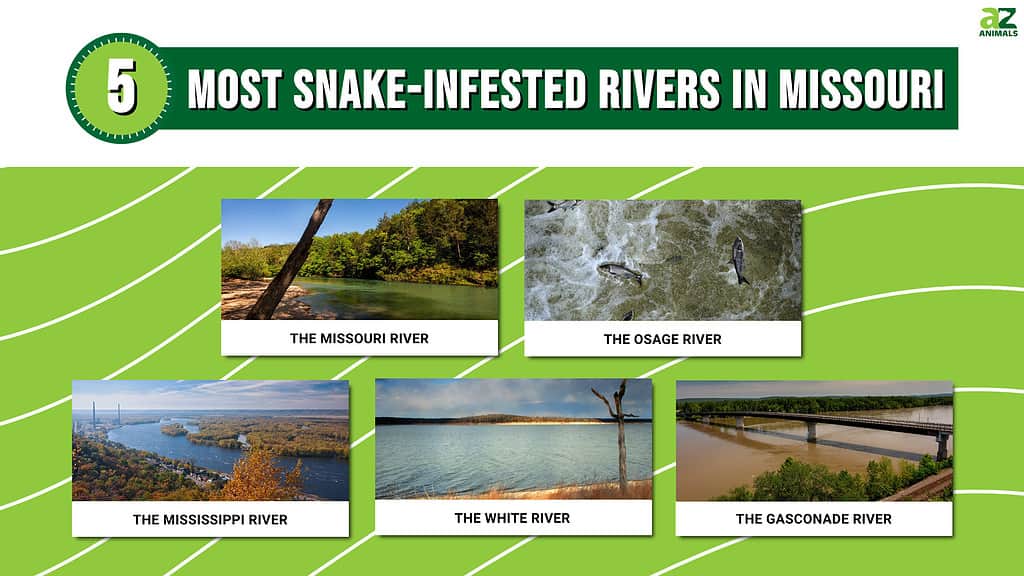
The Top 5 Snake-Infested Rivers in Missouri
Venomous and non-venomous species commonly slither around the most snake-infested rivers in Missouri. While learning about the different types of snakes you might encounter, learn about their habitats, their role in the ecosystem, and how to stay safe if you do encounter a snake on the river.
The Missouri River
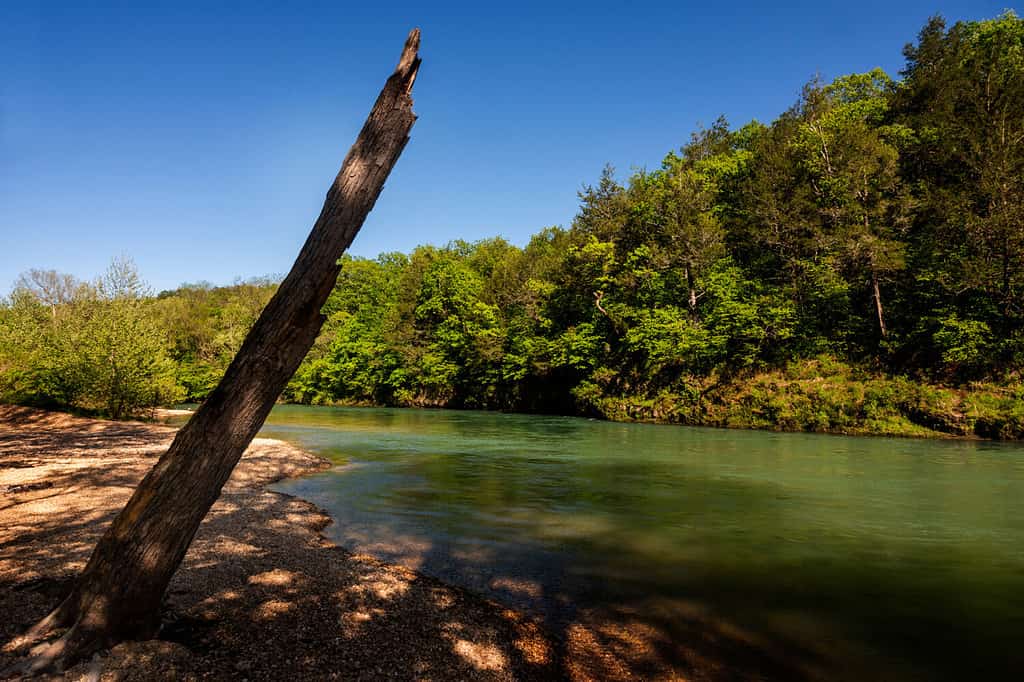
Though the bullsnake seems intimidating, it prefers grassland to spend a life in the water.
©Michael Rolands/Shutterstock.com
Commonly encountered snakes along the Missouri River’s banks include the northern water snake, eastern garter snake, and bullsnake. However, there are over eight different snakes that you be lurking under the waters of the Missouri River as you float along. Because there’s a high percentage to see at least one type of snake in the Missouri River, it’s imperative you know how to identify the venomous species and keep yourself and your family safe in the event of an encounter.
The Osage River
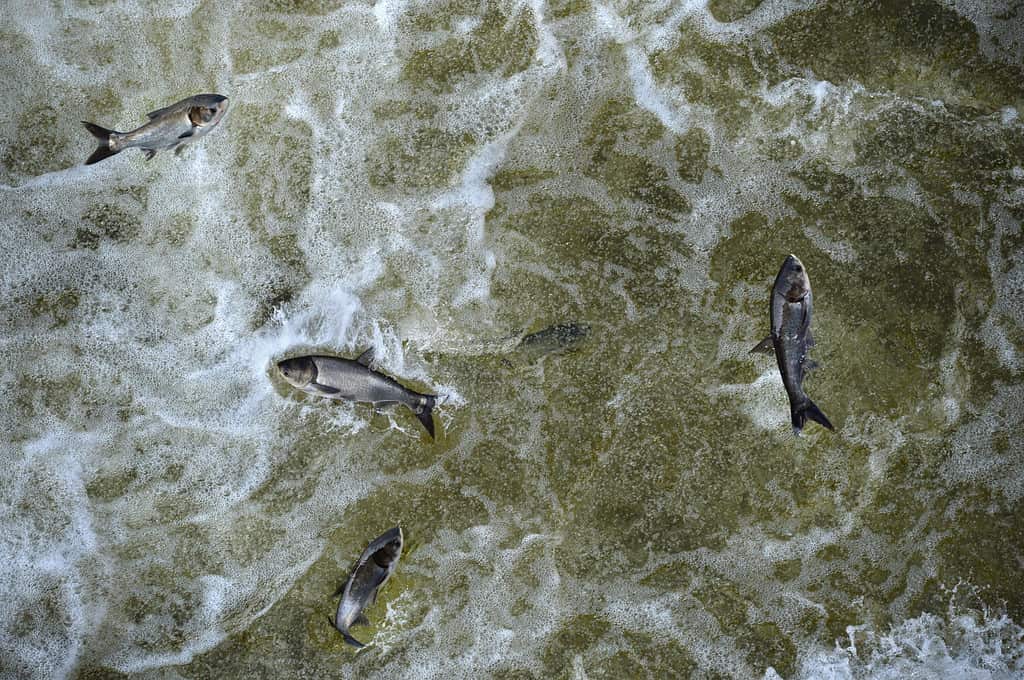
The snakes in the Osage will eat dead fish found near the dam.
©Gino Santa Maria/Shutterstock.com
The Osage River harbors a variety of snake species. Commonly sighted snakes in this region include the eastern rat snake, northern copperhead, and western cottonmouth. Across the river’s banks, you’ll see the eastern rat snake in trees or along rocky outcrops. One of the river’s venomous snakes, the northern copperhead, prefers spending most of its time in wooded areas near water sources. Finally, the western cottonmouth — the other venomous snake — inhabits swamps and marshes along the Osage River.
The Mississippi River

The Common Garter Snake helps control animal populations on the Mississippi River.
©Joe Ferrer/Shutterstock.com
You can find up to 12 different types of snakes in the Mississippi River, including the common garter snake, western ribbon snake, and black rat snake. The latter, specifically, likes to climb the trees on the river bank.
The common garter snake plays a crucial role in controlling insect and small mammal populations near the water’s edge, whereas the western ribbon snake prefers the shallows of the river’s wetland areas to feed on small fish and amphibians. Finally, the black rat snake is an efficient climber and can be spotted near trees and rocky bluffs while hunting.
The White River
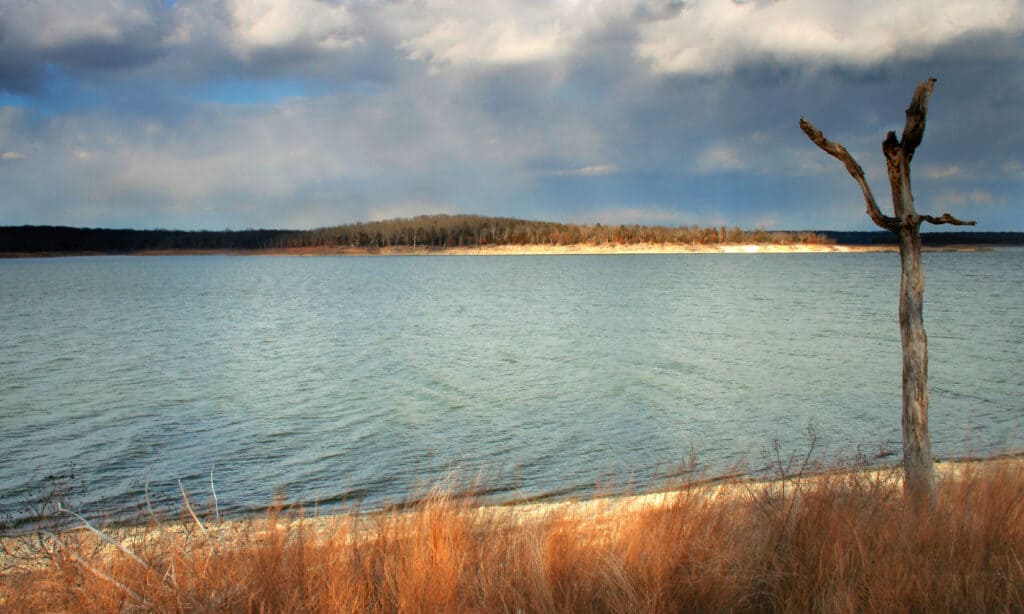
Common snakes in the White River are the eastern hog-nosed snake and the speckled kingsnake.
©iStock.com/StephenFB
The White River has many different snake species, making it the perfect pick for spot number four on the list of the most snake-infested rivers in Missouri. Some of those species include the eastern hog-nosed snake, speckled kingsnake, and western worm snake.
Most of these snakes are non-venomous and use their defense mechanisms to stay alive; like the hog-nosed snake that plays dead when threatened. One of the other two non-venomous snakes in the river, the speckled kingsnake, preys on rodents and other snakes. Finally, the tiny western worm snake can be found under rocks and logs near the river.
The Gasconade River
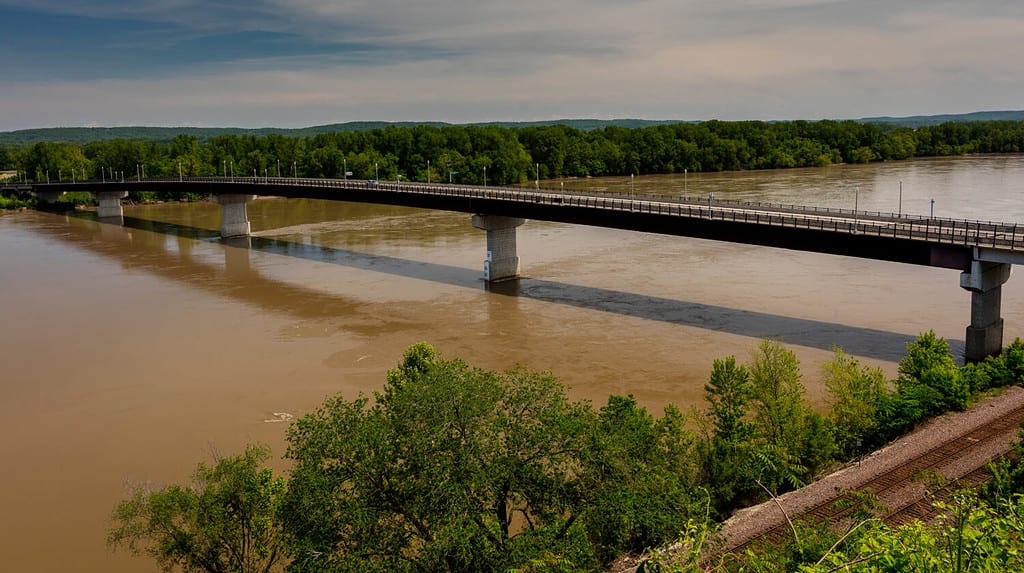
When near the Gasconade, look above to ensure a western ribbon snake won’t drop down on you!
©978674/Shutterstock.com
Commonly encountered snakes include the northern water snake, western ribbon snake, and plains garter snake in the murky waters of the Gasconade. While the species of snakes that swim in the Gasconade remain harmless to humans, that doesn’t mean it’s an invitation to catch or play with the snakes you might encounter. Keep your distance and respect the habitat of any snake you see.
Summary of The 5 Most Snake-Infested Rivers in Missouri
Here are the five most snake-infested rivers in Missouri:
| Rank | Rivers |
|---|---|
| 1 | The Missouri River |
| 2 | The Osage River |
| 3 | The Mississippi River |
| 4 | The White River |
| 5 | The Gasconade River |
Staying Safe While Enjoying Missouri Rivers
While most snakes will avoid humans, some mentioned above will bite or lash out when they feel threatened or cornered. As such, it’s important to let someone know about your plans when you go out to enjoy Missouri’s wilderness and rivers. Most importantly, tell them the location and duration of your river adventure.
If weather permits, use sturdy footwear and protective clothing to minimize exposure to potential hazards. Stick to designated swimming areas — not places you find on your own that haven’t been entered by humans in a while — and avoid wading among murky waters.
If and when you do see a snake, which is bound to happen at one of the rivers mentioned above, observe them and other wildlife from a safe distance. Never attempt to handle them or chase them down.
Snakebite First Aid and What to Do
Regardless of the snake’s venom potency or species, it’s crucial to seek medical help promptly after a snakebite. Professional medical care can properly assess the situation, administer antivenom if necessary, and monitor the victim for potential complications. Even bites from non-venomous snakes can lead to infection or allergic reactions. Delaying medical attention may lead to severe consequences or permanent damage. Always err on the side of caution and prioritize seeking medical help after any snake encounter.
Practice Respect and Safety in Missouri’s Snake-Infested Rivers
The rivers in Missouri teem with fun experiences for the family, diverse ecosystems to explore, and a plethora of different snake populations. From venomous to land roving, the different snakes in Missouri have a large role to play in the habitats of the rivers throughout the state. Though off-putting in unexpected encounters, snakes are usually more scared of humans and will turn tail to run if not provoked or threatened.
By respecting snakes’ space, allowing them to live their lives quietly, and understanding their role in the large ecosystems of Missouri, explorers can foster an enjoyable cohabitation in Missouri rivers with the snake populations that call the beds and grasslands around them home.
The photo featured at the top of this post is © Wspin/Shutterstock.com
Thank you for reading! Have some feedback for us? Contact the AZ Animals editorial team.







